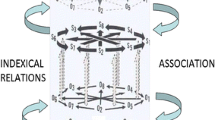Abstract
In this article, we will discuss how computational social symbol grounding (i.e. how shared sets of symbols are grounded in multi-agent models) can be used to study children’s acquisition of word-meaning mappings. In order to use multi-agent modelling as a reliable tool to study human language acquisition, we argue that the simulations need to be anchored in observations of social interactions that children encounter “in the wild” and in different cultures. We discuss what aspects of such social interactions and cognitive mechanisms can and should be modelled, as well as how we intend to anchor this model to corpora containing features of children’s social behaviour as observed “in the wild” to mimic children’s (social) environment as reliably as possible. In addition, we discuss some challenges that need to be solved in order to construct the computational model. The resulting SCAFFOLD model will provide a benchmark for investigating socio-cognitive mechanisms of human social symbol grounding using computer simulations.

Similar content being viewed by others
Notes
References
Bakeman R, Adamson L (1984) Coordinating attention to people and objects in mother-infant and peer-infant interaction. Child Dev 55:1278–1289
Bangerter A, Oppenheimer D (2006) Accuracy in detecting referents of pointing gestures unaccompanied by language. Gesture 6(1):85–102
Barwise J, Perry J (1983) Situations and attitudes. MIT Press, Cambridge
Blythe R, Smith K, Smith A (2010) Learning times for large lexicons through cross-situational learning. Cogn Sci 34(4):620–642
Brown P (2011) The cultural organization of attention. In: The handbook of language socialization, pp 29–55
Carpenter M, Nagell K, Tomasello M, Butterworth G, Moore C (1998) Social cognition, joint attention, and communicative competence from 9 to 15 months of age. Monographs of the society for research in child development, vol 63(4)
Chouinard MM, Clark EV (2003) Adult reformulations of child errors as negative evidence. J Child Lang 30(3):637–669
Clark HH (1996) Using language. Cambridge University Press, Cambridge
Coradeschi S, Saffiotti A (2003) An introduction to the anchoring problem. Robot Auton Syst 43(2):85–96
Fenson L, Dale PS, Reznick JS, Thal D, Bates E, Hartung J, Pethick S, Reilly J (1993) The MacArthur communicative development inventories: user’s guide and technical manual. Singular Publishing Group, San Diego
Frank M, Goodman N, Tenenbaum J (2009) Using speakers’ referential intentions to model early cross-situational word learning. Psychol Sci 20(5):578–585
Gleitman L (1990) The structural sources of verb meanings. Lang Acquis 1:3–55
Harnad S (1990) The symbol grounding problem. Physica D 42:335–346
Hart B, Risley T (1995) Meaningful differences in the everyday experience of young American children. Paul H Brookes Publishing, Baltimore
Keller H, Völker S, Yovsi R (2005) Conceptions of parenting in different cultural communities: the case of West African NSO and northern German women. Soc Dev 14(1):158–180
Kwisthout J, Vogt P, Haselager P, Dijkstra T (2008) Joint attention and language evolution. Connect Sci 20:155–171
Markman E, Hutchinson J (1984) Children’s sensitivity to constraints on word meaning: taxonomic versus thematic relations. Cogn Psychol 16(1):1–27
Markman EM, Wachtel GF (1988) Children’s use of mutual exclusivity to constrain the meaning of words. Cogn Psychol 20:121–157
Mastin JD, Vogt P (submitted) Analyzing infant engagement: filling the gaps in research approaches
Mastin JD, Vogt P (submitted) Correlations between joint engagement and vocabulary development: a longitudinal, observational study of Mozambican infants from 1;1 to 2;1
Peirce CS (1931–1958) Collected papers, vols I–VIII. Harvard University Press, Cambridge
Quine WVO (1960) Word and object. Cambridge University Press, Cambridge
Rosch E (1978) Principles of categorization. In: Rosch E, Lloyd BB (eds) Cognition and categorization. Lawrence Erlbaum Ass, Hilldate
Rowe M, Goldin-Meadow S (2009) Differences in early gesture explain SES disparities in child vocabulary size at school entry. Science 323(5916):951–953
Schieffelin B, Ochs E (1989) Language socialization across cultures. Cambridge University Press, Cambridge
Siskind JM (1996) A computational study of cross-situational techniques for learning word-to-meaning mappings. Cognition 61:39–91
Smith K, Smith A, Blythe R (2011) Cross-situational learning: an experimental study of word-learning mechanisms. Cogn Sci 35(3):480–498
Smith LB, Yu C (2008) Infants rapidly learn word-referent mappings via cross-situational statistics. Cognition 106(3):1558–1568
Snedeker J (2009) Word learning. In: Encyclopedia of neuroscience, pp 503–508
Soja NN, Carey S, Spelke ES (1991) Ontological categories guide young children’s inductions of word meanings: object terms and substance terms. Cognition 38:179–211
Steels L (2003) Evolving grounded communication for robots. Trends Cogn Sci 7(7):308–312. doi:10.1016/S1364-6613(03)00129-3
Tomasello M, Carpenter M, Call J, Behne T, Moll H (2005) Understanding and sharing intentions: the origins of cultural cognition. Behav Brain Sci 28(05):675–691
Vogt P (2002) The physical symbol grounding problem. Cogn Syst Res 3(3):429–457
Vogt P (2012) Exploring the robustness of cross-situational learning under Zipfian distributions. Cogn Sci 36:726–739
Vogt P, de Boer B (2010) Language evolution: computer models for empirical data. Adapt Behav 18(1):5–11
Vogt P, Divina F (2007) Social symbol grounding and language evolution. Interact Stud 8(1):31–52
Vogt P, Haasdijk E (2010) Modelling social learning of language and skills. Artif Life 16(4):289–310
Vogt P, Lieven E (2010) Verifying theories of language acquisition using computer models of language evolution. Adapt Behav 18:21–35
Vogt P, Mastin JD (submitted) Child-directed speech and co-speech gestures’ correlations with vocabulary development in rural and urban Mozambique
Vygotsky L (1978) Mind in society. Harvard University Press, Harvard
Yu C, Ballard D (2007) A unified model of early word learning: integrating statistical and social cues. Neurocomputing 70(13–15):2149–2165
Zukow-Goldring P (1996) Sensitive caregiving fosters the comprehension of speech: when gestures speak louder than words. Early Dev Parent 5(4):195–211
Acknowledgements
The research presented in this article is funded by a Vidi grant awarded to the first author by the Netherlands Organisation for Scientific Research (NWO, grant no. 276-70-018). The authors are indebted to Wona Sanana and the Associação Communitario Ambiente de Mafalala for their assistance in recruiting the Mozambican participants, all Mozambican and Dutch research assistants for helping to collect and annotate the data, and all Mozambican and Dutch participants.
Author information
Authors and Affiliations
Corresponding author
Rights and permissions
About this article
Cite this article
Vogt, P., Mastin, J.D. Anchoring Social Symbol Grounding in Children’s Interactions. Künstl Intell 27, 145–151 (2013). https://doi.org/10.1007/s13218-013-0243-6
Published:
Issue Date:
DOI: https://doi.org/10.1007/s13218-013-0243-6




